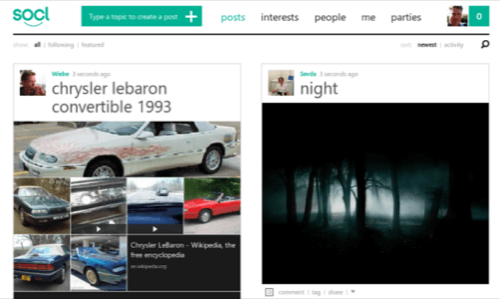
Microsoft’s Socl social network, now open to all, is big, bright and beautiful. And perhaps just a bit too much of each.
Although Socl became available in May to students, Microsoft employees, and some VIPs, this week Microsoft opened up the site to the world at large. Socl still identifies itself as “beta.so.cl,” perhaps indicating that it’s not quite completed. But in a hands-on with the new site on Wednesday, I encountered no bugs, and every feature the site promised, it delivered.
The Casual Social Network
What is Socl? Think of it as a casual social network, like Pinterest, but more verbose. And with some elements of Google+ thrown in for good measure. Basically, Socl makes it extremely easy to share Web pages, images and videos you’ve found on the Web (with Microsoft’s Bing search engine, of course), and even like them with a “Smile” icon. And while there’s a dash of the “Metro-style” typography from Windows 8, it’s neither obtrusive nor one of the primary design elements. Remember, Socl was originally designed by Fuse Labs, part of Microsoft’s research arm.
Socl opens by asking you if you’d like to log in with your Facebook or Microsoft account. While there isn’t an option to sign in with just a user name or password, Microsoft reassures you that the site will never post on your timeline without your permission. (I turned my Facebook privacy settings for the associated Socl app to “just me,” just in case.) However, if you sign in via Microsoft, the Socl VNext app will view your name, email, gender and contact list, including the email addresses of your friends. That might seem a bit offputting, until you realize that many other social networks, including Google+, does the same.
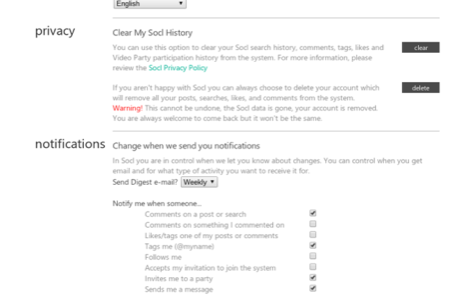
A privacy page offers you the ability to control notifications, and erase all content from the system. But keep in mind – and for privacy nuts, this is paramount – what you post will be seen, at least for a few seconds, by the entire world, and who ever searches for it. Socl is far more consistent with Mark Zuckerberg’s concept of “everything is shared” than Facebook is.
Right In The Thick Of It
After signing in, Socl drops you into the thick of it: the front page. As far as I can tell, every post made to the site ends up here, although just for a second or two: As you’ll quickly notice, each post – dominated by a picture or pictures – takes up at least a third or half of the available space. Combine that with the frequency that others post, and your “Hello World!” introduction won’t last long. Make it interesting enough, however, and you’ll pick up your first Followers.
Yep, Followers.
Like Twitter, you can follow who you like, and a “People” page shows some of the most popular users, including those you’ve chosen to follow and those who follow you. At this early stage, there’s a disproportionate number of Microsoft employees, but the looky-loos from the Internet at large may soon alleviate that. I was disappointed by the lack of an easy option to follow a user who had added an interesting post, however. I had to click into the post, then to the user’s profile page, and then add him – not as convenient as I would have liked.
At this point, you’ll probably feel overwhelmed. If so, it might be worth heading to the “Interests” tab, where you’ll be able to narrow down your search. At the top of the page, picture-driven categories like “Tech” and “Music” appear, and you’re always welcome to search for a topic using the small magnifying glass icon to the middle right.
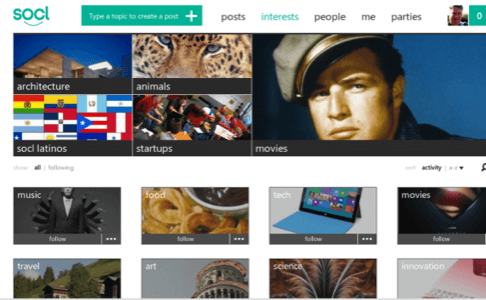
When Is A Search Box Not A Search Box?
Microsoft made an odd choice by including what looks like a search box at the top of each page. It’s not. Instead, typing in a topic there creates a post, using that word as the first search term.
And creating content is where Socl shines. Yes, Pinterest focuses on images as well. But creating a post on Socl takes just seconds: add a headline, search Bing for images, links or videos, and drag them over to the posting box. Microsoft and Fuse have put themselves on the cutting edge here, and Facebook feels old and tired by comparison.
Each photo layout is the same, however: one main image, with several smaller ones. Each picture will resize itself to fit in, with some dynamic reorganization in places to maintin the relative alignment and photo format. There’s a limit, though, of about three small square photo icons, and about fifteen rows. While you can add movie links, clicking on the icon for the “Prometheus” trailer I added took me to the Yahoo page it was housed in, rather than playing the video directly from the page.
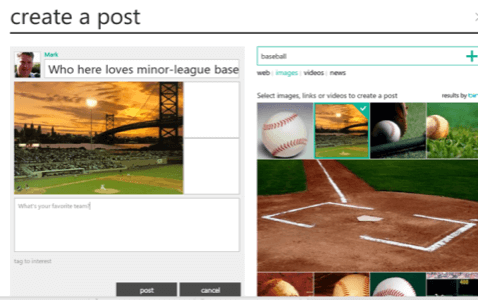
Parties Aren’t Any Fun
If you want to share videos, “Parties” may be a better choice. At this point, “Parties” is a vague enough term that I suspect this tab will be beefed up in the future; I suspect it will eventually include Google Hangout-style video chats, powered by Microsoft’s Skype.
For now, however, Parties is the place to loop videos, and where others can drop in to join them. But it doesn’t work very well.
Instead of a collaborative, living-room feel, Parties feels like an art installation, where a film loop plays in a darkened room. People drop in, holding a virtual glass of champagne, mutter something about Bauhaus and butterflies, and depart. Even though Microsoft allows users to post images from Google’s YouTube, the controls are gone: you can’t pause, rewind, fast-forward or even put the video into a full-screen mode. It’s nearly useless, especially for long-form content.
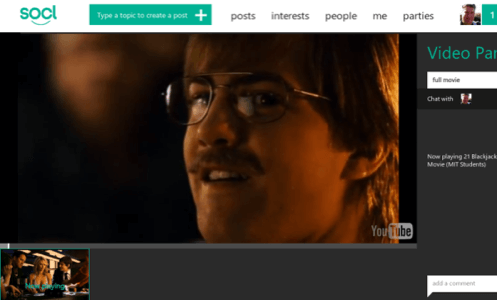
Socl’s “Firehose” Makes It Worth A Visit
In general, Socl is worth a visit. If you understand that nothing you post on Socl is truly private, it’s a bit of a rush. Yes, we’ll probably see the spammers drop in. Some marginally risque photos have already surfaced, although users can flag such content as inappropriate. And each picture is too big; I’d like the option to shrink things down to a more pleasing size.
But Socl offers something that other social networks don’t: the chance to ride the firehose. To be carried along by every user that publishes something to the system. Compare that with Quora, which absolutely refuses to let you in unless you sign up for the system, and then wants to provide you only with content your friends care about.
I hate that. I like to break free occasionally, to cast myself in the raging torrent of serendipity and encounter things I never knew existed. Will I be able to grab hold, and establish a clique of content providers like I have on Twitter? I don’t know. But for right now, I’m enjoying the uncertainty.










